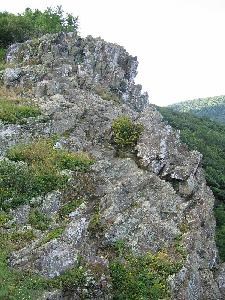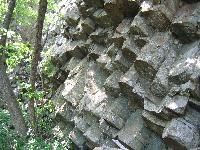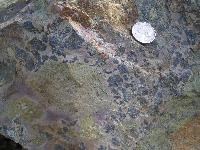
Eric Butler - NPS Photo Perhaps the most unique rocks in These eruptions did not occur all at once, but over a period of several million years. Discrete eruptions produced individual flows from 20’ to over 100’ thick, which spread over the landscape and cooled before the next eruption. These distinct lava flows still affect the landscape of Shenandoah today, as the individual layers create flat “benches” and sheer cliffs that give peaks such as Stony Man a noticeably staircase-like texture. Big Meadows, a broad, near-flat area at high elevation, is located on the surface of one of these lava flows. The lavas were originally composed of basalt, a black volcanic rock similar to those found in Shenandoah’s greenstone lava flows can have many different appearances. They often appear as jagged cliffs, or steep fields of angular grey boulders. In general, the rocks are very fine-grained, so that individual minerals can rarely be seen. On a freshly broken face, the rocks look dark grey to dark green, but more weathered and eroded surfaces often appear light grey or rust-red. In many cases the rocks appear to contain many thin layers tilted at a sharp angle, producing an uneven, jagged look; this is a metamorphic texture called “cleavage”, formed by deformation and the growth of the mineral chlorite. The greenstones also contain several very unique and interesting geologic features. The first is columnar jointing, a fracture pattern that forms as liquid basalt flows cool and solidify. Like most materials, lava contracts as it cools, and under the right conditions will form very angular, polygonal cracks similar to those found in drying mud. These cracks can extend vertically for many tens of feet, and produce a structure that looks like long, polygonal columns of rock. The best example of these along 
Eric Butler - NPS Photo Another memorable feature of the greenstones is found between some individual lava flows. Here you may find a rock composed of fragments of other rock mixed together. As new lava flows advanced across older, solidified flows, they often ripped up the surface of the older flow, as well as any sediments that may have been deposited by short-lived rivers. Thus, the boundary between flows is often marked by a chaotic layer of mixed-up rock fragments and sediments that has a very distinct appearance. This type of rock is known as “breccia”, and in Shenandoah it generally contains an eye-catching blend of colors including lime green, dark purple, and white. This breccia is often found as loose rocks on the flat “benches” separating cliffs of different lava flows. The best example of this rock along Skyline Drive can be found at Franklin Cliffs Overlook (milepost 49), mostly as scattered pieces in the trees next to the parking area. 
Eric Butler - NPS Photo Excellent exposures of greenstone can be found at both summits of Mount Marshall, Stony Man Mt, Little Stony Man, Hawksbill, Blackrock Central (at Big Meadows Lodge), Bearfence Mt, Pass Mt, Loft Mt, and Hightop Mt. |
Last updated: February 26, 2015
